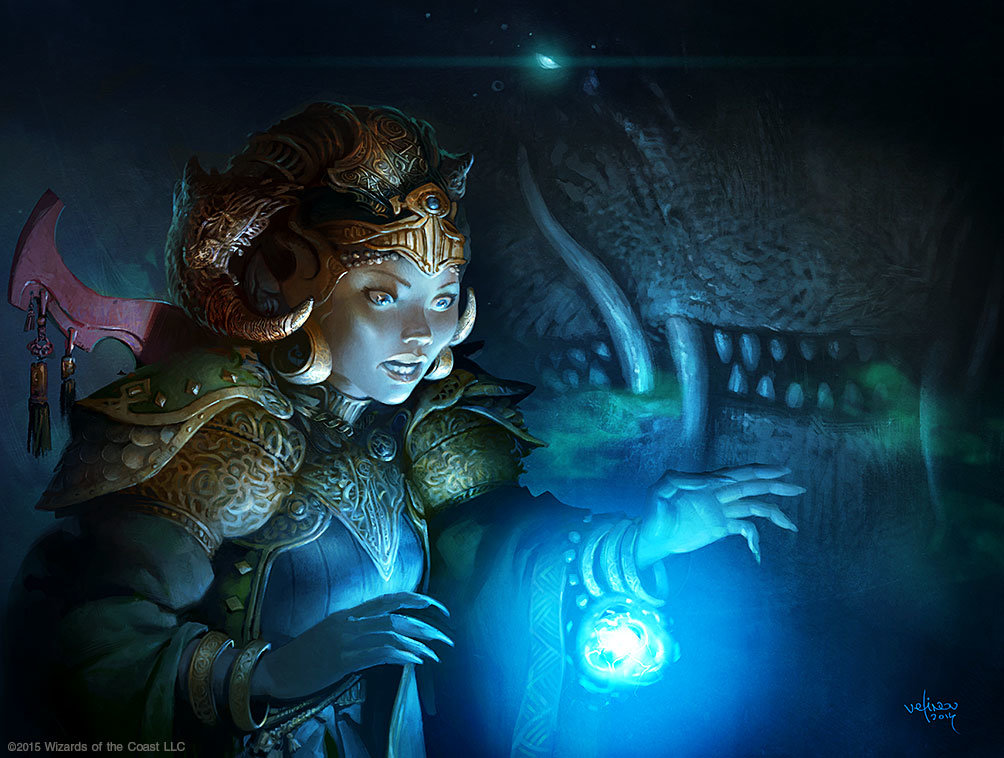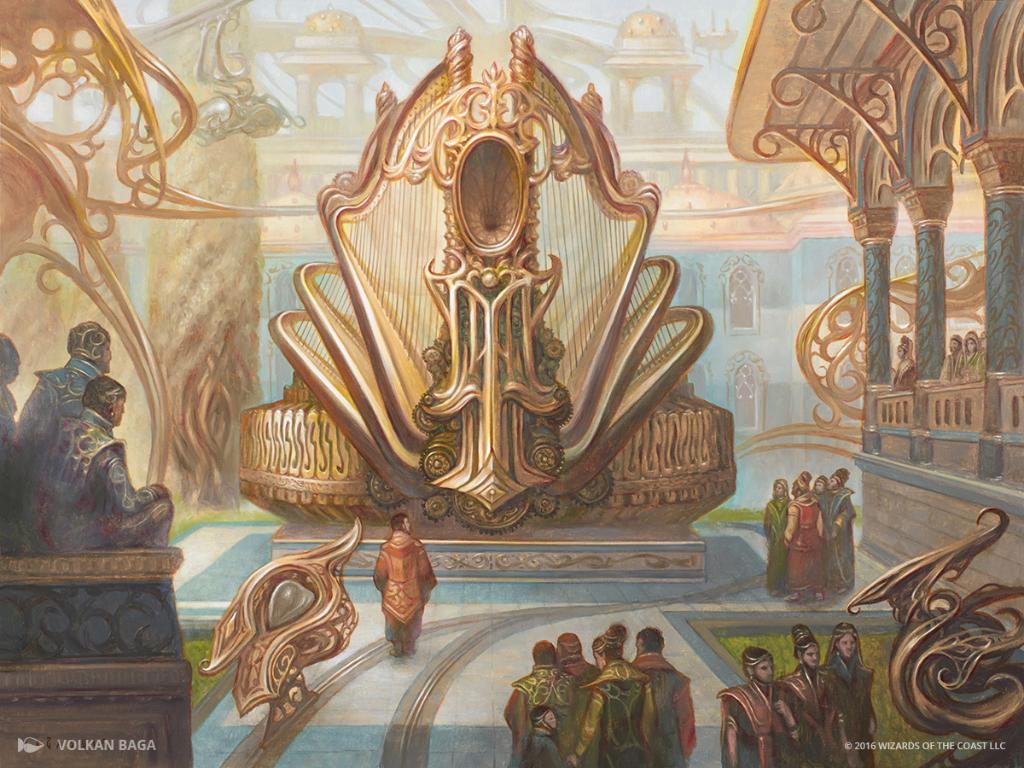Also: check out Episodes 59 and 60 of the Beacon of Creation custom Magic design podcast, to see these lenses used in action. I made a guest appearance helping Bradley Rose, Adam Victor Klesh, and Juliet Louis with their community set, Castmire!
 |
| Extraplanar Lens by Lars Grant-West |
Interest Lens
 |
| Fascination by Svetlin Velinov |
Researchers at the Education University of Hong Kong have developed an "interest-driven creator (IDC) theory", a framework for how interest can be used to engage people. While it was designed for pedagogy, it is perfectly suited to game design!
 |
| The Interest Loop, by Wong, Chan, Chen, King, and Wong (2015) |
The interest loop has three major components, each guiding players into the next. Your goal is to not just catch a player's attention, but to hold it, and that means having something for every component, to maintain the loop. Not all mechanics are amazing at every component. But truly interesting mechanics have to maintain the loop themselves.
Triggering Interest
 |
| Panharmonicon by Volkan Baga |
 |
| Curious Obsession by Daniel Ljunggren |
The best strategy is to get players curious. Players curious how your mechanic plays are driven to understand it. Your goal is to have them realize the best way to understand your mechanic is by playing with it.
If your mechanic is too complex, confusing, or tough to parse, players won't be curious; they'll get lost. The more work the player has to do to reach the mechanic itself, the less interesting the mechanic will be. Your mechanic should be punchy: clear and straight to the point. Good flavor helps trigger interest, as the resonance gives players access to prior knowledge. The easier you make playing with your mechanic, the more likely the players will do so.
But, a mechanic that triggers interest well should, at the same time, be tough to evaluate. You want players to think the best way to understand it is by playing with it. Therefore, mechanics that best provoke curiosity tend to be be controversial, or open-ended, or even unprecedented.
 Some mechanics have quite the uphill battle in this respect. Many players initially dismissed exalted off-handedly, underestimating how interesting it was. However, once players gave it a chance, they realized that it made for very interesting games! Unleash and mentor had similar struggles. Mechanics like this are actually quite important to a game. These mechanics surprise players, and Magic needs surprises.
Some mechanics have quite the uphill battle in this respect. Many players initially dismissed exalted off-handedly, underestimating how interesting it was. However, once players gave it a chance, they realized that it made for very interesting games! Unleash and mentor had similar struggles. Mechanics like this are actually quite important to a game. These mechanics surprise players, and Magic needs surprises.
Mechanics can be interesting despite bad first impressions, but your set can't only include such mechanics. If you have no mechanics which trigger interest, there's no hook for players to give your game a shot! Yet, our goal isn't just to catch a player's interest fleetingly. We need to hold it.
Immersing Interest
 |
| Dive Down by Magali Villeneuve |
Immersing interest means engaging the full attention of a player. Being immersed in gameplay means pushing the limits of your skill, confronting challenges, and having fun doing so. Immerson requires the full attention of a player. Avoid distractions, like shuffling, complex rules interactions, and so on. You want players to be devoting their brainpower to the gameplay. Nothing else!
Immersive mechanics should achieve a balance between being skill-testing and approachable. Too skill-testing, and players will be frustrated. They'll never feel like they made the right choice. Too simple, and you won't have a puzzle to solve.
Just as resonance helps trigger interest, smooth gameplay helps immerse interest. You need to maximize your mechanic's opportunities to present interesting decisions to players. The more your mechanic's impact is felt throughout the game, the more interesting it becomes.
 A recent example of a mechanic good at immersing interest is exert. As discussed by Ari Lax, exert was at its best when it had you decide how to "push into a large range of potential, difficult, but viable blocks". Note what Ari Lax considered an improvement for exert between Amonkhet and Hour of Devastation. Exert was more interesting when it went from presenting impossible blocks, to tricky blocks. The additional constraints added to blocking for your opponent actually make the situation more interesting. This is because they're also calculations the exerting player has to make.
A recent example of a mechanic good at immersing interest is exert. As discussed by Ari Lax, exert was at its best when it had you decide how to "push into a large range of potential, difficult, but viable blocks". Note what Ari Lax considered an improvement for exert between Amonkhet and Hour of Devastation. Exert was more interesting when it went from presenting impossible blocks, to tricky blocks. The additional constraints added to blocking for your opponent actually make the situation more interesting. This is because they're also calculations the exerting player has to make.The more these decisions impact the game, the better. Sometimes, like with exert, this means presenting multiple opportunities to make a decision. Other times, like with riot, this means presenting only one decision, but making that decision greatly matter. The presence of absence of a +1/+1 counter is a long-term decision, after all. That one decision can also be something that the player has to choose when to make, such as with monstrosity. Even without activating monstrosity, it affects how you value that creature, and how you spend your mana.
Now, imagine your mechanic made a good first impression. A player put it in their deck and played with it. As this is in an interest loop, we need to find a way to bridge between immersing interest, and triggering interest again. But our player has already seen and played with this mechanic. How could we trigger their interest again?
Extending Interest
 |
| Kodama's Reach by Heather Hudson |
What comes next after a game with an untested card? Reflection. Magic is a deck-building game, and we change our decks based on how they play. The next step for our imagination exercise is for us to imagine our player tweaking their deck. If your mechanic has been interesting so far, they'll want to add cards that work well with it!
 Mechanics that extend a player's interest have meaningful implications for Magic. Such mechanics cause you to reevaluate other cards, and by doing so, make them more interesting. Cards you might not have valued before are suddenly important. Or, cards traditionally good in a format are now not so important. The presence of delirium in Shadows over Innistrad, for example, made some cards far more useful than they historically had been. The Vessel cycle, for example, suddenly become much more interesting to players looking to achieve delirium.
Mechanics that extend a player's interest have meaningful implications for Magic. Such mechanics cause you to reevaluate other cards, and by doing so, make them more interesting. Cards you might not have valued before are suddenly important. Or, cards traditionally good in a format are now not so important. The presence of delirium in Shadows over Innistrad, for example, made some cards far more useful than they historically had been. The Vessel cycle, for example, suddenly become much more interesting to players looking to achieve delirium.
Many mechanics that extend interest do so by affecting deckbuilding. Landfall pushes players to jam more lands in their decks. It makes them prize additional land drops. Prowess, too, encourages players to find a way to include as many noncreature spells in their deck as possible.
Extending interest sparks anew the interest loop. Your mechanics should have relationships with each other ranging from the obvious to the obscure. The obvious serve as scaffolding. Players need some easy discoveries to feel triumphant, to have fun, and to ease into your set. You want a wide spread towards the obscure to keep the format feeling fresh, as dedicated players continually discover something new.
It is no coincidence that the interest loop spans the overall gameplay of Magic: acquiring cards, playing with cards, and building decks with your cards. Magic can hold players' attention so well because it was made around the interest loop.
Undercover is a good example of "benchmark interesting". It doesn't wow most people. But it hooks people, and keeps them hooked. Being able to play your spells face down as an Exultant Cultist triggers interest well. (Most face-down mechanics do.) It's tough to evaluate, as it's hard to tell how powerful this card advantage is, or how relevant the 2/2 might be, and it's relatively unprecedented.
Once a player decides to play with it, it immerses their interest with its deep gameplay. Undercover creatures are easy to kill, but your opponent doesn't want to kill them. Likewise, players want to get their mana's worth from the 2/2, but they also want it to die. This makes board states with undercover creatures very interesting, and quite surprising to people expecting them to play like morph.
Even when the undercover creature dies, it presents interesting gameplay. The best undercover spells require players to take unusual actions to maximize their advantage. For example, one "dead drop" card that surprised everyone in playtests simply gained 8 life. The ability to gain 8 life pushes players to make some very interesting decisions. Those same decisions, however, arouse the suspicion of your opponent. Not blocking when you're near death suddenly becomes a clue that you have that spell.
I couldn't have said it better myself.
 |
| Time Warp by Jon Foster |
Please share your stories about interesting mechanics in the comments! I always love to read and reply to what you all have to say. They can be stories about making interesting mechanics, or about mechanics you find particularly interesting!
Until next article, may you have interesting times.

I've not seen anyone go deep on this subject, and it's enlightening. Rosewater has hinted at some of this, but it always helps to think about something explicitly. Thanks, Trevor.
ReplyDeleteSorry I've been so slow to respond to this!
ReplyDeleteWhen they introduced addendum in Ravica Allegiance, I (as a blue/white fan) had a similar reaction that Golgari players had to undergrowth: This isn't how I want to play these colors!
Using your writing here as a model, I don't think they succeeded in making addendum a mechanic that really holds interest and definitely doesn't extend interest. It's a situation where it's not that it's a "bad" mechanic so much as its a mechanic that's value is subtle enough that it doesn't really speak to an identity. I've actually thought about designing spells that use the concept of addendum (and its opposite--cards more powerful on the opponent's turn), but I didn't really think about keywording it because it didn't really feel like it was going to create a "style" of play that justified it.
And the connection between mechanic and identity is a huge part of what makes Ravnica Ravnica. The identity of Azorious in limited ended up not being about addendum at all, but with a familiar white-blue play pattern of defensive controlling with a few creatures to serve as win conditions. Blue and white is by no means bad in this set--Apparently the pros did quite well drafting Azorius in last weekend's big tournament. But it just didn't hold my interest.
It's kind of fascinating because U/W actually did hold my interest in Ixalan (partly because it wasn't supposed to and that of course appealed to my Mel/Johnny side) and I loved it in Dominaria. But in Ravnica, I'm still all about Dimir.
I'm curious if any designers actually found addendum to be a mechanic that drew and maintained interest.
Addendum is boring.
DeleteIt's almost like a guild flavorfully themed around being boring and repetitive can have mechanics that accurately represent its flavor theme, or mechanics that people actually want to play with, but not both.
DeleteDetain was great. Why didn't they bring back detain?
I have a theory that detain would have made Azorius paradoxically too aggressive in limited and this is a very, very slow set. (If I do another series of guest posts, what I learned about how the slowness of the set affected mechanics will definitely be a theme)
DeleteAnd in standard ... I do have to wonder how access to detain would have affected the Teferi/Nexus decks, though it could have been implemented in such a way that it wasn't efficient enough to make the cut in top decks.
Another observation on addendum:
DeleteAddendum appears on both the fewest total cards out of any guild mechanic (9) and the lowest ratio of non-rare to mythic/rare (6, or 67%, with one of the three addendum rares being mythic).
For what it's worth, of the ten guild mechanics from this time around, Addendum is my favorite to play with. I don't think its existence does a lot to shape the set (I would argue basically none of the guild mechanics do this time around), but a lot of the designs are very fun, and in particular Dovin's Acuity is a super fun card.
DeleteReverse Addendum doesn't feel like it'll be worth exploring all too much. Spells are almost always already inherently stronger on the opponent's turn, it wouldn't change that play pattern. There might be a select few interesting cards it can go on, mostly combat tricks come to mind, but I'm not sure it's deep enough.
DeleteReverse addendum is giving me flashbacks to Lorwyn Fae.
DeleteOh yes, I abandoned the idea of "reverse addendum" very quickly once I recognized that it reinforced part of the U/W play pattern that opponents hate the most. I did try to template a mechanic where a spell was boosted when cast in response to an opponent's spell, but found it very hard to template without referring to the stack.
Delete